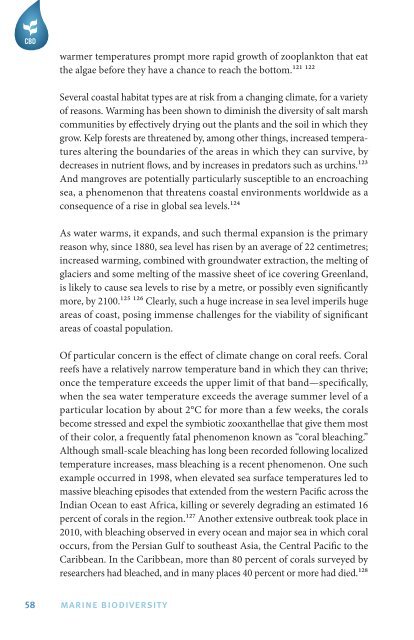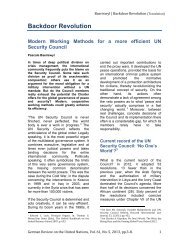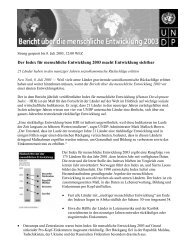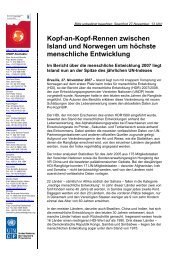One Ocean, Many Worlds of Life - Convention on Biological Diversity
One Ocean, Many Worlds of Life - Convention on Biological Diversity
One Ocean, Many Worlds of Life - Convention on Biological Diversity
Create successful ePaper yourself
Turn your PDF publications into a flip-book with our unique Google optimized e-Paper software.
warmer temperatures prompt more rapid growth <str<strong>on</strong>g>of</str<strong>on</strong>g> zooplankt<strong>on</strong> that eat<br />
the algae before they have a chance to reach the bottom.121 122<br />
Several coastal habitat types are at risk from a changing climate, for a variety<br />
<str<strong>on</strong>g>of</str<strong>on</strong>g> reas<strong>on</strong>s. Warming has been shown to diminish the diversity <str<strong>on</strong>g>of</str<strong>on</strong>g> salt marsh<br />
communities by effectively drying out the plants and the soil in which they<br />
grow. Kelp forests are threatened by, am<strong>on</strong>g other things, increased temperatures<br />
altering the boundaries <str<strong>on</strong>g>of</str<strong>on</strong>g> the areas in which they can survive, by<br />
decreases in nutrient flows, and by increases in predators such as urchins.123<br />
And mangroves are potentially particularly susceptible to an encroaching<br />
sea, a phenomen<strong>on</strong> that threatens coastal envir<strong>on</strong>ments worldwide as a<br />
c<strong>on</strong>sequence <str<strong>on</strong>g>of</str<strong>on</strong>g> a rise in global sea levels.124<br />
As water warms, it expands, and such thermal expansi<strong>on</strong> is the primary<br />
reas<strong>on</strong> why, since 1880, sea level has risen by an average <str<strong>on</strong>g>of</str<strong>on</strong>g> 22 centimetres;<br />
increased warming, combined with groundwater extracti<strong>on</strong>, the melting <str<strong>on</strong>g>of</str<strong>on</strong>g><br />
glaciers and some melting <str<strong>on</strong>g>of</str<strong>on</strong>g> the massive sheet <str<strong>on</strong>g>of</str<strong>on</strong>g> ice covering Greenland,<br />
is likely to cause sea levels to rise by a metre, or possibly even significantly<br />
more, by 2100.125 126 Clearly, such a huge increase in sea level imperils huge<br />
areas <str<strong>on</strong>g>of</str<strong>on</strong>g> coast, posing immense challenges for the viability <str<strong>on</strong>g>of</str<strong>on</strong>g> significant<br />
areas <str<strong>on</strong>g>of</str<strong>on</strong>g> coastal populati<strong>on</strong>.<br />
Of particular c<strong>on</strong>cern is the effect <str<strong>on</strong>g>of</str<strong>on</strong>g> climate change <strong>on</strong> coral reefs. Coral<br />
reefs have a relatively narrow temperature band in which they can thrive;<br />
<strong>on</strong>ce the temperature exceeds the upper limit <str<strong>on</strong>g>of</str<strong>on</strong>g> that band—specifically,<br />
when the sea water temperature exceeds the average summer level <str<strong>on</strong>g>of</str<strong>on</strong>g> a<br />
particular locati<strong>on</strong> by about 2°C for more than a few weeks, the corals<br />
become stressed and expel the symbiotic zooxanthellae that give them most<br />
<str<strong>on</strong>g>of</str<strong>on</strong>g> their color, a frequently fatal phenomen<strong>on</strong> known as “coral bleaching.”<br />
Although small-scale bleaching has l<strong>on</strong>g been recorded following localized<br />
temperature increases, mass bleaching is a recent phenomen<strong>on</strong>. <str<strong>on</strong>g>One</str<strong>on</strong>g> such<br />
example occurred in 1998, when elevated sea surface temperatures led to<br />
massive bleaching episodes that extended from the western Pacific across the<br />
Indian <str<strong>on</strong>g>Ocean</str<strong>on</strong>g> to east Africa, killing or severely degrading an estimated 16<br />
percent <str<strong>on</strong>g>of</str<strong>on</strong>g> corals in the regi<strong>on</strong>.127 Another extensive outbreak took place in<br />
2010, with bleaching observed in every ocean and major sea in which coral<br />
occurs, from the Persian Gulf to southeast Asia, the Central Pacific to the<br />
Caribbean. In the Caribbean, more than 80 percent <str<strong>on</strong>g>of</str<strong>on</strong>g> corals surveyed by<br />
researchers had bleached, and in many places 40 percent or more had died.128<br />
58 Marine BiOdiversity

















